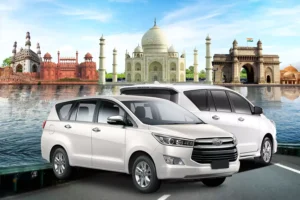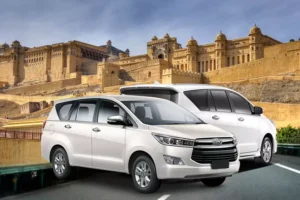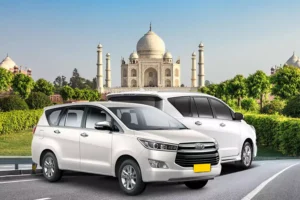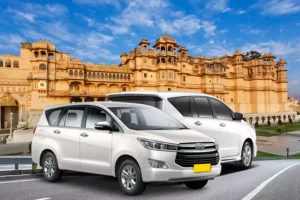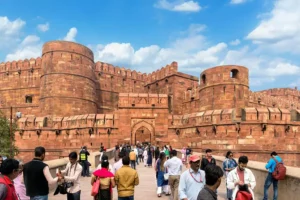Best Tiger Reserves India”?
There’s something wild and almost unreal about seeing a tiger in the wild. Not behind a fence — but right there, walking through the forest like it owns the land. This article from Rajasthan Tour Driver brings together 10 of India’s most unforgettable tiger safari spots — and each one tells a different story.
You’ve got Ranthambore, where tigers walk past old ruins, and Corbett, tucked into the Himalayan foothills, full of rivers and thick jungle. Bandhavgarh offers a real shot at tiger sightings with its high density, while Kanha feels more peaceful — all open meadows and whispering Sal trees.
Then there’s Pench, straight out of The Jungle Book, and Tadoba, raw and unfiltered, where tigers show up when you least expect it. The east gives you Kaziranga, packed with rhinos and tall grass hiding big cats, and Nagarhole, where nature is loud, green, and full of life.
Want something wilder? Head to the Sundarbans, where tigers swim through mangroves, or Satpura, quieter and less touristy — perfect for those who like their safaris slow and deep.
Each park pulls you in differently. But all of them? They remind you what wild really looks like.

Overview of Ranthambore National Park, Rajasthan
Ranthambore National Park, located in the Sawai Madhopur district of Rajasthan, is one of India’s largest and most famous national parks. Spanning over 1,334 square kilometers, it was established as a national park in 1980 and is a part of the Sawai Mansingh Wildlife Sanctuary. Renowned for its population of Bengal tigers, Ranthambore offers a unique opportunity to see these magnificent creatures in their natural habitat.
The park is characterized by its diverse landscapes, including dry deciduous forests, rocky hills, and expansive grasslands, interspersed with lakes and ancient ruins. One of its most iconic features is the Ranthambore Fort, a UNESCO World Heritage Site, which stands atop a hill and offers stunning panoramic views of the park and surrounding areas.
Ticket Prices for Ranthambore National Park
Entry Fees (As of 2025-26):
- Indian Citizens: ₹50 per person
- Foreign Nationals: ₹500 per person
- Children (up to 5 years): Free entry
Vehicle Fees:
- Gypsy (Open Vehicle): ₹4,500 for a private vehicle (up to 6 people)
- Canter (Open Bus): ₹1,500 per person (shared)
- Personal Vehicle: Entry fees plus vehicle charges apply.
Safari Charges:
- Jeep Safari: ₹3,000 to ₹4,500 (depending on the zone and vehicle type)
- Canter Safari: ₹1,500 to ₹2,000 per person (shared)
Note: Prices may vary based on the season and type of safari booked. It’s advisable to check the official website or contact the park administration for the latest rates before planning your visit.
Visiting Information
Best Time to Visit: The best time to visit Ranthambore National Park is from October to April. The park is open from 1st October to 30th June, while it remains closed during the monsoon season (July to September) to protect wildlife and for safety reasons. The winter months (November to February) offer a chance to see tigers and other wildlife more clearly, while summer (March to June) is ideal for spotting animals near waterholes as temperatures rise.
How to Reach:
- By Air: The nearest airport is Jaipur International Airport, approximately 180 km away. Taxis are available for hire to reach the park.
- By Train: The nearest railway station is Sawai Madhopur, about 10 km from the park, which is well-connected to major cities.
- By Road: Ranthambore is accessible by road from major cities in Rajasthan, including Jaipur and Udaipur. Regular buses and taxis operate from these locations.
Accommodation: The park offers various accommodation options, ranging from budget hotels and guesthouses to luxury resorts. Popular options include the Ranthambore Kothi, The Oberoi Vanyavilas, and Ranthambore Heritage Haveli. It’s advisable to book in advance, especially during peak tourist seasons.
Activities: Visitors can enjoy a range of activities in Ranthambore National Park, including:
- Jeep Safaris: Explore the park’s wildlife and landscapes.
- Canter Safaris: A larger, shared vehicle option for safaris.
- Bird Watching: With over 300 species of birds, the park is a paradise for bird enthusiasts.
- Visit Ranthambore Fort: Explore the historic fort and enjoy panoramic views of the park.
Safety Guidelines: When visiting the park, it is essential to follow safety guidelines to ensure a safe and enjoyable experience. Always stay inside the vehicle during safaris, do not feed the animals, and adhere to the instructions of your guides.
Conclusion
Ranthambore National Park is a captivating destination for wildlife enthusiasts and photographers, offering an unparalleled experience of nature and wildlife. With its stunning landscapes, diverse wildlife, and rich cultural history, it provides a unique opportunity to connect with the wilderness and witness the beauty of India’s natural heritage. Whether you're eager to catch a glimpse of a tiger or simply want to explore the serene surroundings, a visit to Ranthambore promises unforgettable adventures and cherished memories.

Overview of Jim Corbett National Park, Uttarakhand
Jim Corbett National Park, nestled in the foothills of the Himalayas in Uttarakhand, is India's oldest national park, established in 1936 as Hailey National Park. Spanning over 520 square kilometers, this stunning wildlife sanctuary is renowned for its diverse flora and fauna, especially the majestic Bengal tiger, which is a significant attraction for wildlife enthusiasts and photographers. The park is a part of the larger Corbett Tiger Reserve, which is home to a variety of species, including elephants, leopards, deer, and over 600 species of birds, making it a paradise for nature lovers.
The park is characterized by its breathtaking landscapes, including dense forests, grassy meadows, and rivers, offering visitors an opportunity to experience the tranquility of nature. Corbett is not only a habitat for wildlife but also a significant ecological zone, making it a vital area for conservation efforts.
Ticket Prices for Jim Corbett National Park
Entry Fees (As of 2025-26):
- Indian Citizens: ₹50 per person
- Foreign Nationals: ₹600 per person
- Children (up to 5 years): Free entry
Vehicle Fees:
- Gypsy (Open Vehicle): ₹4,500 (including entry fees for 6 people)
- Canter (Open Bus): ₹1,500 per person for 6 people
- Personal Vehicle: Entry fees plus vehicle charges apply.
Safari Charges:
- Jeep Safari: ₹3,500 to ₹4,500 (depending on the zone and vehicle type)
- Canter Safari: ₹1,500 to ₹2,000 per person (shared)
Note: The prices may vary based on the season and type of safari booked. It’s advisable to check the official website or contact the park administration for the latest rates before planning your visit.
Visiting Information
Best Time to Visit: The best time to visit Jim Corbett National Park is from November to June. The park remains closed during the monsoon season (July to September) to protect wildlife and for safety reasons. Winter months (November to February) offer a chance to see tigers and other wildlife more clearly, while summer (March to June) is ideal for spotting animals near waterholes as temperatures rise.
How to Reach:
- By Air: The nearest airport is Pantnagar Airport, approximately 80 km away from the park. Taxis are available for hire to reach the park.
- By Train: The nearest railway station is Ramnagar, about 12 km from the park, which is well-connected to major cities.
- By Road: Jim Corbett is accessible by road from major cities in Uttarakhand and neighboring states. Regular buses and taxis operate from Delhi, Nainital, and Ranikhet.
Accommodation: The park offers various accommodation options, ranging from budget hotels and lodges to luxury resorts. It’s advisable to book in advance, especially during peak tourist seasons.
Activities: Visitors can enjoy various activities in Jim Corbett National Park, including:
- Jeep Safaris: Explore the park's wildlife and landscapes.
- Elephant Rides: Experience the park from a unique vantage point.
- Bird Watching: Ideal for bird enthusiasts, with numerous species to spot.
- Nature Walks and Trekking: Explore the scenic beauty and diverse ecosystems of the park.
Safety Guidelines: When visiting the park, it's essential to follow safety guidelines to ensure a safe and enjoyable experience. Always stay inside the vehicle during safaris, do not feed the animals, and adhere to the instructions of your guides.
Conclusion
Jim Corbett National Park is a remarkable destination for wildlife enthusiasts and nature lovers alike. With its stunning landscapes, diverse wildlife, and numerous activities, it offers a unique opportunity to connect with nature and experience the thrill of wildlife safaris. Whether you're an avid photographer or simply looking to unwind in a serene environment, a visit to Jim Corbett National Park promises unforgettable memories.

Overview of Bandhavgarh National Park, Madhya Pradesh
Bandhavgarh National Park, located in the Umaria district of Madhya Pradesh, is one of India's premier wildlife reserves and is renowned for its significant population of Bengal tigers. Established as a national park in 1968, Bandhavgarh covers an area of approximately 448 square kilometers and is set against the backdrop of the majestic Vindhya mountain range. The park is named after the historic Bandhavgarh Fort, which sits atop a hill and offers stunning views of the surrounding landscape.
The rich biodiversity of Bandhavgarh makes it a haven for wildlife enthusiasts and nature lovers. The park is home to a variety of species, including leopards, deer (such as sambar and chital), wild boars, and over 250 species of birds. The diverse ecosystems within the park, comprising dense sal forests, open meadows, and rocky hills, contribute to its ecological significance and beauty.
Ticket Prices for Bandhavgarh National Park
Entry Fees (As of 2025-26):
- Indian Citizens: ₹50 per person
- Foreign Nationals: ₹600 per person
- Children (up to 5 years): Free entry
Vehicle Fees:
- Gypsy (Open Vehicle): ₹3,500 (including entry fees for up to 6 people)
- Canter (Open Bus): ₹1,200 per person (shared)
- Personal Vehicle: Entry fees plus vehicle charges apply.
Safari Charges:
- Jeep Safari: ₹3,500 to ₹4,500 (depending on the zone and vehicle type)
- Canter Safari: ₹1,200 to ₹1,800 per person (shared)
Note: Prices may vary based on the season and type of safari booked. It’s advisable to check the official website or contact the park administration for the latest rates before planning your visit.
Visiting Information
Best Time to Visit: The best time to visit Bandhavgarh National Park is from October to June. The park is open year-round, but it remains closed during the monsoon season (July to September) due to heavy rainfall. The winter months (November to February) offer cooler weather and increased wildlife visibility, while the summer months (March to June) provide the best chances of spotting tigers as they come out to drink from waterholes.
How to Reach:
- By Air: The nearest airport is Jabalpur Airport, approximately 200 km from the park. Taxis are available for hire to reach Bandhavgarh.
- By Train: The nearest railway station is Umaria, about 35 km away from the park. It is well-connected to major cities like Jabalpur and Katni.
- By Road: Bandhavgarh is accessible by road from major cities in Madhya Pradesh, including Jabalpur, Katni, and Khajuraho. Regular buses and taxis operate from these locations.
Accommodation: The park offers a range of accommodation options, from budget lodges and hotels to luxury resorts. Popular choices include the Bandhavgarh Jungle Lodge, Mahua Kothi, and Tiger's Den Resort. It’s advisable to book in advance, especially during peak tourist seasons.
Activities: Visitors can enjoy a variety of activities in Bandhavgarh National Park, including:
- Jeep Safaris: Explore the park's wildlife and natural beauty.
- Canter Safaris: A larger, shared vehicle option for safaris.
- Bird Watching: Ideal for birdwatchers, with numerous species to observe.
- Visit Bandhavgarh Fort: Explore the ancient fort, rich in history and architecture.
Safety Guidelines: When visiting the park, it's crucial to follow safety guidelines to ensure a safe and enjoyable experience. Always stay inside the vehicle during safaris, do not feed the animals, and adhere to the instructions of your guides.
Conclusion
Bandhavgarh National Park is a captivating destination for wildlife enthusiasts and photographers, offering a remarkable experience of India's rich biodiversity. With its stunning landscapes, diverse wildlife, and historical significance, the park provides a unique opportunity to connect with nature and witness the beauty of wildlife in their natural habitat. Whether you’re eager to spot a tiger or simply want to immerse yourself in the serenity of nature, a visit to Bandhavgarh promises unforgettable adventures and lasting memories.

Overview of Kaziranga National Park, Assam
Kaziranga National Park, located in the northeastern state of Assam, is one of India's most famous wildlife sanctuaries and a UNESCO World Heritage Site. Spanning over 430 square kilometers, the park is renowned for its successful conservation efforts, particularly in protecting the Indian one-horned rhinoceros. Kaziranga is characterized by its diverse ecosystems, including lush grasslands, dense forests, marshlands, and riverine habitats, making it a biodiversity hotspot.
The park is home to the largest population of the one-horned rhinoceros in the world, as well as a variety of other wildlife species, including tigers, elephants, swamp deer, and a wide range of bird species. Kaziranga’s unique landscape and rich flora and fauna make it a paradise for nature lovers and wildlife enthusiasts.
Ticket Prices for Kaziranga National Park
Entry Fees (As of 2025-26):
- Indian Citizens: ₹50 per person
- Foreign Nationals: ₹1,000 per person
- Children (up to 5 years): Free entry
Vehicle Fees:
- Jeep Safari (Open Vehicle): ₹3,500 for up to 6 people
- Canter Safari (Open Bus): ₹1,500 per person (shared)
- Personal Vehicle: Entry fees plus vehicle charges apply.
Safari Charges:
- Jeep Safari: ₹3,500 to ₹5,000 (depending on the zone and vehicle type)
- Canter Safari: ₹1,500 to ₹2,500 per person (shared)
Note: Prices may vary based on the season and type of safari booked. It’s advisable to check the official website or contact the park administration for the latest rates before planning your visit.
Visiting Information
Best Time to Visit: The best time to visit Kaziranga National Park is from November to April. The park is closed during the monsoon season (May to October) due to heavy rains and the risk of flooding. The winter months (November to February) offer cooler weather and better visibility for wildlife spotting, while spring (March to April) is ideal for experiencing the park's lush greenery and blooming flora.
How to Reach:
- By Air: The nearest airport is Jorhat Airport, approximately 97 km from the park. Alternatively, Guwahati Airport (about 217 km away) is well-connected to major cities.
- By Train: The nearest railway station is Furkating, about 75 km from Kaziranga, with connections to various cities.
- By Road: Kaziranga is accessible by road from major cities in Assam, including Guwahati and Jorhat. Regular buses and taxis operate from these locations.
Accommodation: Kaziranga offers a range of accommodation options, from budget lodges and guesthouses to luxury resorts. Popular options include the Kaziranga National Park Resort, Iora Resort, and Bon Habi Resort. It’s advisable to book in advance, especially during peak tourist seasons.
Activities: Visitors can enjoy various activities in Kaziranga National Park, including:
- Jeep Safaris: Explore the park’s wildlife and landscapes.
- Elephant Safaris: A unique way to experience the park from a different perspective.
- Bird Watching: Ideal for bird enthusiasts, with over 480 species of birds recorded in the park.
- Nature Walks and Treks: Discover the park's diverse ecosystems and flora.
Safety Guidelines: When visiting the park, it's essential to follow safety guidelines to ensure a safe and enjoyable experience. Always stay inside the vehicle during safaris, do not feed the animals, and adhere to the instructions of your guides.
Conclusion
Kaziranga National Park is a remarkable destination for wildlife enthusiasts and nature lovers, offering a unique opportunity to witness the beauty of India's natural heritage. With its stunning landscapes, diverse wildlife, and successful conservation efforts, Kaziranga provides an unforgettable experience for visitors. Whether you're eager to see the iconic one-horned rhinoceros or simply want to explore the park's rich biodiversity, a visit to Kaziranga promises adventure, serenity, and cherished memories.

Overview of Tadoba Andhari Tiger Reserve, Maharashtra
Tadoba Andhari Tiger Reserve, located in the Chandrapur district of Maharashtra, is one of India's largest and oldest national parks, renowned for its rich biodiversity and thriving population of Bengal tigers. Established in 1995 as a tiger reserve, it covers an area of approximately 625 square kilometers, including the Tadoba National Park and Andhari Wildlife Sanctuary. The reserve is characterized by its diverse ecosystems, which include dense forests, grasslands, lakes, and streams, making it an ideal habitat for various wildlife species.
Tadoba is particularly famous for its tiger population and is considered one of the best places in India to observe these majestic animals in their natural habitat. The reserve is also home to a variety of other wildlife, including leopards, sloth bears, Indian wild dogs, various deer species, and over 300 species of birds. With its picturesque landscapes and vibrant wildlife, Tadoba Andhari offers an exceptional experience for nature lovers and wildlife enthusiasts.
Ticket Prices for Tadoba Andhari Tiger Reserve
Entry Fees (As of 2025-26):
- Indian Citizens: ₹50 per person
- Foreign Nationals: ₹600 per person
- Children (up to 5 years): Free entry
Vehicle Fees:
- Gypsy (Open Vehicle): ₹3,000 to ₹4,500 (for a private vehicle, accommodating up to 6 people)
- Canter (Open Bus): ₹1,500 to ₹2,000 per person (shared)
- Personal Vehicle: Entry fees plus vehicle charges apply.
Safari Charges:
- Jeep Safari: ₹3,500 to ₹5,000 (depending on the zone and vehicle type)
- Canter Safari: ₹1,500 to ₹2,500 per person (shared)
Note: Prices may vary based on the season and type of safari booked. It’s advisable to check the official website or contact the park administration for the latest rates before planning your visit.
Visiting Information
Best Time to Visit: The best time to visit Tadoba Andhari Tiger Reserve is from October to June. The park remains closed during the monsoon season (July to September) due to heavy rainfall and the risk of flooding. The winter months (November to February) provide cooler temperatures and better visibility for wildlife spotting, while the summer months (March to June) offer optimal chances for observing tigers as they come out to waterholes.
How to Reach:
- By Air: The nearest airport is Nagpur Airport, approximately 140 km from the reserve. Taxis and buses are available for hire to reach Tadoba.
- By Train: The nearest railway station is Chandrapur, about 30 km away from the park, which is well-connected to major cities in Maharashtra.
- By Road: Tadoba is accessible by road from major cities like Nagpur, Chandrapur, and Wardha. Regular buses and taxis operate from these locations.
Accommodation: Tadoba Andhari offers a variety of accommodation options, ranging from budget lodges and guesthouses to luxury resorts. Popular options include the Tadoba Tiger Resort, Svasara Jungle Lodge, and Jungle Retreat Tadoba. It’s advisable to book in advance, especially during peak tourist seasons.
Activities: Visitors can enjoy several activities in Tadoba Andhari Tiger Reserve, including:
- Jeep Safaris: Explore the park's wildlife and diverse landscapes.
- Canter Safaris: A larger, shared vehicle option for safaris.
- Bird Watching: With over 300 bird species, the reserve is a paradise for bird enthusiasts.
- Nature Walks and Trekking: Discover the park's flora and fauna through guided walks.
Safety Guidelines: When visiting the reserve, it's crucial to follow safety guidelines to ensure a safe and enjoyable experience. Always stay inside the vehicle during safaris, do not feed the animals, and adhere to the instructions of your guides.
Conclusion
Tadoba Andhari Tiger Reserve is a remarkable destination for wildlife enthusiasts, photographers, and nature lovers, offering a unique opportunity to witness the beauty of India’s rich biodiversity. With its stunning landscapes, thriving tiger population, and a variety of other wildlife species, Tadoba provides an unforgettable experience for visitors. Whether you're eager to spot a tiger, explore the diverse ecosystems, or simply enjoy the tranquility of nature, a visit to Tadoba Andhari promises adventure and cherished memories.

Overview of Pench National Park, Madhya Pradesh
Pench National Park, located in the Seoni and Chhindwara districts of Madhya Pradesh, is one of India’s most enchanting wildlife reserves. Spanning an area of approximately 758 square kilometers, it is named after the Pench River, which flows through the park. Established as a national park in 1983 and later designated as a tiger reserve in 1993, Pench is renowned for its picturesque landscapes, including lush forests, grassy meadows, and serene water bodies.
The park is particularly famous for its diverse wildlife, including a significant population of Bengal tigers, leopards, deer species (such as sambar and chital), wild boars, and a variety of birds. The captivating scenery and abundant wildlife make Pench National Park a favorite destination for nature lovers, wildlife enthusiasts, and photographers.
Ticket Prices for Pench National Park
Entry Fees (As of 2025-26):
- Indian Citizens: ₹50 per person
- Foreign Nationals: ₹500 per person
- Children (up to 5 years): Free entry
Vehicle Fees:
- Gypsy (Open Vehicle): ₹3,500 (for a private vehicle accommodating up to 6 people)
- Canter (Open Bus): ₹1,200 to ₹1,500 per person (shared)
- Personal Vehicle: Entry fees plus vehicle charges apply.
Safari Charges:
- Jeep Safari: ₹3,500 to ₹4,500 (depending on the zone and vehicle type)
- Canter Safari: ₹1,200 to ₹1,800 per person (shared)
Note: Prices may vary based on the season and type of safari booked. It’s advisable to check the official website or contact the park administration for the latest rates before planning your visit.
Visiting Information
Best Time to Visit: The best time to visit Pench National Park is from October to June. The park remains closed during the monsoon season (July to September) due to heavy rains and the risk of flooding. The winter months (November to February) offer cooler temperatures and better wildlife visibility, while the summer months (March to June) are ideal for spotting tigers as they come to drink at waterholes.
How to Reach:
- By Air: The nearest airport is Nagpur Airport, approximately 90 km from the park. Taxis and buses are available for hire to reach Pench.
- By Train: The nearest railway station is Seoni, about 30 km away from the park, which is well-connected to major cities.
- By Road: Pench is accessible by road from major cities like Nagpur, Jabalpur, and Seoni. Regular buses and taxis operate from these locations.
Accommodation: Pench National Park offers a variety of accommodation options, from budget lodges and guesthouses to luxury resorts. Popular options include Pench Jungle Camp, Tuli Tiger Corridor, and Jungle Home Resort. It’s advisable to book in advance, especially during peak tourist seasons.
Activities: Visitors can enjoy various activities in Pench National Park, including:
- Jeep Safaris: Explore the park's wildlife and breathtaking landscapes.
- Canter Safaris: A larger, shared vehicle option for safaris.
- Bird Watching: With over 285 species of birds, the park is a paradise for bird enthusiasts.
- Nature Walks: Discover the flora and fauna through guided treks and walks.
Safety Guidelines: When visiting the park, it's essential to follow safety guidelines to ensure a safe and enjoyable experience. Always stay inside the vehicle during safaris, do not feed the animals, and adhere to the instructions of your guides.
Conclusion
Pench National Park is a captivating destination for wildlife enthusiasts, photographers, and nature lovers, offering a unique opportunity to witness the beauty of India’s rich biodiversity. With its stunning landscapes, thriving wildlife, and serene atmosphere, Pench provides an unforgettable experience for visitors. Whether you're eager to spot a tiger, explore the diverse ecosystems, or simply enjoy the tranquility of nature, a visit to Pench National Park promises adventure, excitement, and cherished memories.

Overview of Sundarbans National Park, West Bengal
Sundarbans National Park, a UNESCO World Heritage Site, is one of the largest mangrove forests in the world, located in the Sundarbans delta in West Bengal, India. Covering an area of approximately 1,330 square kilometers, this unique ecosystem is known for its intricate network of rivers, estuaries, and islands, providing a habitat for diverse flora and fauna. The park is part of the Sundarbans Biosphere Reserve and is famous for its rich biodiversity, including the elusive Bengal tiger, which is the star attraction of the reserve.
The Sundarbans are also home to a variety of other wildlife, including spotted deer, crocodiles, snakes, and a rich array of bird species, making it a paradise for nature lovers and wildlife enthusiasts. The unique mangrove ecosystem plays a crucial role in coastal protection and supports the livelihoods of the local communities.
Ticket Prices for Sundarbans National Park
Entry Fees (As of 2026):
- Indian Citizens: ₹50 per person
- Foreign Nationals: ₹1,000 per person
- Children (up to 5 years): Free entry
Vehicle Fees:
- Boat Safari: Charges vary based on the type of boat and duration of the safari, generally ranging from ₹1,500 to ₹5,000.
- Personal Boat: Entry fees plus boat charges apply.
Safari Charges:
- Guided Boat Tours: Ranging from ₹2,000 to ₹5,000 per person, depending on the duration and amenities.
Note: Prices may vary based on the season and type of safari booked. It’s advisable to check the official website or contact the park administration for the latest rates before planning your visit.
Visiting Information
Best Time to Visit: The best time to visit Sundarbans National Park is from November to February, when the weather is pleasant, and wildlife sightings are more frequent. The park is closed during the monsoon season (June to September) due to heavy rains and flooding. Winter months offer cooler temperatures and clear visibility, making it ideal for exploring the unique ecosystem and spotting wildlife.
How to Reach:
- By Air: The nearest airport is Netaji Subhas Chandra Bose International Airport in Kolkata, approximately 170 km away from the park. From the airport, taxis and buses can be hired to reach Sundarbans.
- By Train: The nearest railway station is Canning, around 50 km from Sundarbans, which is well-connected to Kolkata and other major cities.
- By Road: Sundarbans is accessible by road from Kolkata, with regular bus services and private vehicles available.
Accommodation: Sundarbans offers various accommodation options, including eco-friendly resorts, guesthouses, and homestays. Popular options include the Sundarbans Jungle Camp, Royal Bengal Resort, and Sunderban Tiger Camp. It is advisable to book in advance, especially during peak tourist seasons.
Activities: Visitors can enjoy several activities in Sundarbans National Park, including:
- Boat Safaris: Explore the intricate waterways and mangrove forests while searching for wildlife.
- Bird Watching: With over 300 species of birds, including migratory birds, the park is a birdwatcher’s paradise.
- Wildlife Photography: Capture stunning images of the unique flora and fauna of the Sundarbans.
- Cultural Tours: Engage with local communities and learn about their way of life and relationship with the mangrove ecosystem.
Safety Guidelines: When visiting the park, it's crucial to follow safety guidelines to ensure a safe and enjoyable experience. Always stay within designated areas, do not feed the animals, and adhere to the instructions of your guides. Given the presence of tigers, it is important to remain cautious during wildlife sightings.
Conclusion
Sundarbans National Park is a mesmerizing destination for wildlife enthusiasts, photographers, and nature lovers, offering a unique opportunity to witness the beauty of one of the world's largest mangrove forests. With its stunning landscapes, rich biodiversity, and vibrant local culture, Sundarbans provides an unforgettable experience for visitors. Whether you're eager to spot the majestic Bengal tiger, explore the intricate mangrove ecosystem, or immerse yourself in the local culture, a visit to Sundarbans National Park promises adventure, serenity, and cherished memories.

Overview of Nagarhole National Park, Karnataka
Nagarhole National Park, also known as Rajiv Gandhi National Park, is a stunning wildlife reserve located in the Kodagu (Coorg) and Mysore districts of Karnataka. Spanning approximately 643 square kilometers, the park is part of the Nilgiri Biosphere Reserve, which is recognized as a UNESCO World Heritage Site. Established in 1988, Nagarhole is renowned for its rich biodiversity, lush forests, and picturesque landscapes, featuring a mix of deciduous and evergreen forests, open grasslands, and serene water bodies.
The park is home to a variety of wildlife, including Bengal tigers, Asian elephants, Indian bison (gaur), spotted deer, and numerous bird species, making it a paradise for nature enthusiasts and wildlife photographers. The tranquil environment, combined with the stunning scenery of hills and valleys, offers a perfect backdrop for wildlife exploration.
Ticket Prices for Nagarhole National Park
Entry Fees (As of 2026):
- Indian Citizens: ₹50 per person
- Foreign Nationals: ₹500 per person
- Children (up to 5 years): Free entry
Vehicle Fees:
- Gypsy (Open Vehicle): ₹3,500 to ₹4,500 (for a private vehicle accommodating up to 6 people)
- Canter (Open Bus): ₹1,200 to ₹1,500 per person (shared)
Safari Charges:
- Jeep Safari: ₹3,500 to ₹4,500 (depending on the zone and vehicle type)
- Canter Safari: ₹1,200 to ₹1,800 per person (shared)
Note: Prices may vary based on the season and type of safari booked. It’s advisable to check the official website or contact the park administration for the latest rates before planning your visit.
Visiting Information
Best Time to Visit: The best time to visit Nagarhole National Park is from October to May. The park remains closed during the monsoon season (June to September) due to heavy rains and the risk of flooding. The winter months (November to February) provide cooler temperatures and better wildlife visibility, while the summer months (March to May) are ideal for spotting tigers and other wildlife as they frequent waterholes.
How to Reach:
- By Air: The nearest airport is Mysore Airport, approximately 90 km from the park. Alternatively, Kempegowda International Airport in Bangalore is around 230 km away, with taxi and bus services available to Nagarhole.
- By Train: The nearest railway station is Mysore, which is well-connected to major cities in India. From Mysore, you can hire a taxi or take a bus to the park.
- By Road: Nagarhole is accessible by road from major cities like Mysore and Coorg, with regular bus services and private vehicles available.
Accommodation: Nagarhole National Park offers various accommodation options, from budget lodges to luxury resorts. Popular choices include the Kabini River Lodge, Nagarhole Jungle Resort, and Evolve Back Resort. It’s advisable to book in advance, especially during peak tourist seasons.
Activities: Visitors can enjoy several activities in Nagarhole National Park, including:
- Jeep Safaris: Explore the park's wildlife and beautiful landscapes.
- Boat Rides: Enjoy a tranquil ride on the Kabini River, which provides opportunities for birdwatching and wildlife spotting.
- Bird Watching: The park is home to over 300 species of birds, making it ideal for bird enthusiasts.
- Nature Walks: Discover the flora and fauna through guided treks and walks.
Safety Guidelines: When visiting the park, it's essential to follow safety guidelines to ensure a safe and enjoyable experience. Always stay inside the vehicle during safaris, do not feed the animals, and adhere to the instructions of your guides.
Conclusion
Nagarhole National Park is a captivating destination for wildlife enthusiasts, nature lovers, and photographers, offering a unique opportunity to witness the beauty of India’s rich biodiversity. With its stunning landscapes, diverse wildlife, and serene atmosphere, Nagarhole provides an unforgettable experience for visitors. Whether you're eager to spot a majestic tiger, explore the vibrant ecosystem, or simply enjoy the tranquility of nature, a visit to Nagarhole National Park promises adventure, excitement, and cherished memories.

Overview of Kanha National Park, Madhya Pradesh
Kanha National Park, one of India’s largest and most renowned national parks, is located in the central Indian state of Madhya Pradesh. Spanning over 940 square kilometers, Kanha is celebrated for its remarkable biodiversity, picturesque landscapes, and rich wildlife. Established in 1955, the park is famous for its successful conservation efforts, particularly in protecting the endangered Bengal tiger and the barasingha (swamp deer). The park's diverse ecosystems include lush sal forests, rolling grasslands, and bamboo thickets, making it a stunning destination for wildlife enthusiasts and nature lovers.
Kanha National Park is home to a variety of wildlife, including tigers, leopards, wild dogs, Indian bison, and a plethora of bird species. The park's extensive network of trails and well-maintained safari routes allows visitors to explore its natural beauty and observe its inhabitants in their natural habitats.
Ticket Prices for Kanha National Park
Entry Fees (As of 2026):
- Indian Citizens: ₹50 per person
- Foreign Nationals: ₹1,000 per person
- Children (up to 5 years): Free entry
Vehicle Fees:
- Gypsy (Open Vehicle): ₹3,500 to ₹4,500 (for a private vehicle accommodating up to 6 people)
- Canter (Open Bus): ₹1,200 to ₹1,500 per person (shared)
Safari Charges:
- Jeep Safari: ₹3,500 to ₹4,500 (depending on the zone and vehicle type)
- Canter Safari: ₹1,200 to ₹1,800 per person (shared)
Note: Prices may vary based on the season and type of safari booked. It’s advisable to check the official website or contact the park administration for the latest rates before planning your visit.
Visiting Information
Best Time to Visit: The ideal time to visit Kanha National Park is from October to June. The park is closed during the monsoon season (July to September) due to heavy rains and the risk of flooding. The winter months (November to February) offer pleasant weather, making it suitable for wildlife viewing, while the summer months (March to June) are great for spotting tigers as they come out to cool off near water sources.
How to Reach:
- By Air: The nearest airport is Jabalpur Airport, approximately 160 km from Kanha. From the airport, taxis and buses can be hired to reach the park. Another option is the Raipur Airport, which is around 250 km away.
- By Train: The nearest railway station is Gondia, approximately 145 km from the park. Jabalpur Railway Station is also a good option, about 160 km away, well-connected to major cities.
- By Road: Kanha is accessible by road from major cities like Jabalpur, Nagpur, and Raipur, with regular bus services and private vehicles available.
Accommodation: Kanha National Park offers a range of accommodation options, from budget hotels to luxury resorts. Popular choices include the Taj Safari Lodge, Kanha Earth Lodge, and Jungle Lodge. It is advisable to book in advance, especially during peak tourist seasons.
Activities: Visitors can enjoy several activities in Kanha National Park, including:
- Jeep Safaris: Explore the park's diverse wildlife and stunning landscapes.
- Nature Walks: Discover the flora and fauna through guided treks in designated areas.
- Bird Watching: The park is home to over 300 species of birds, making it a haven for bird enthusiasts.
- Wildlife Photography: Capture breathtaking images of the park's rich biodiversity.
Safety Guidelines: When visiting the park, it’s essential to follow safety guidelines to ensure a safe and enjoyable experience. Always stay inside the vehicle during safaris, do not feed the animals, and adhere to the instructions of your guides.
Conclusion
Kanha National Park is a breathtaking destination for wildlife lovers, photographers, and nature enthusiasts, offering a unique opportunity to experience the beauty of India’s natural heritage. With its stunning landscapes, rich biodiversity, and well-conserved habitats, Kanha provides an unforgettable experience for visitors. Whether you’re eager to spot a majestic tiger, explore the enchanting forests, or simply enjoy the tranquility of nature, a visit to Kanha National Park promises adventure, excitement, and cherished memories.

Overview of Satpura National Park, Madhya Pradesh
Satpura National Park, located in the Hoshangabad district of Madhya Pradesh, is a stunning and lesser-known gem in India’s wildlife sanctuary repertoire. Established in 1981, the park spans over 440 square kilometers and is part of the larger Satpura Biosphere Reserve, which encompasses a variety of ecosystems, including deciduous forests, grasslands, and rocky hills. The park's unique topography includes the Satpura mountain range, offering a diverse habitat for flora and fauna.
The park is renowned for its rich biodiversity, featuring an array of wildlife, including Bengal tigers, leopards, sloth bears, Indian bison (gaur), and various species of deer. It also hosts a multitude of bird species, making it a haven for birdwatchers and nature enthusiasts. Unlike many other national parks in India, Satpura is known for its emphasis on eco-tourism, allowing visitors to engage more intimately with nature through walking safaris and canoe rides, which provide a unique perspective on the park's stunning landscapes and wildlife.
Ticket Prices for Satpura National Park
Entry Fees (As of 2026):
- Indian Citizens: ₹50 per person
- Foreign Nationals: ₹500 per person
- Children (up to 5 years): Free entry
Vehicle Fees:
- Gypsy (Open Vehicle): ₹3,500 to ₹4,500 (for a private vehicle accommodating up to 6 people)
- Canter (Open Bus): ₹1,200 to ₹1,500 per person (shared)
Safari Charges:
- Jeep Safari: ₹3,500 to ₹4,500 (depending on the zone and vehicle type)
- Canoe Ride: Approximately ₹500 to ₹1,000 per person
Note: Prices may vary based on the season and type of safari booked. It’s advisable to check the official website or contact the park administration for the latest rates before planning your visit.
Visiting Information
Best Time to Visit: The best time to visit Satpura National Park is from October to June. The park remains closed during the monsoon season (July to September) due to heavy rainfall and potential flooding. The winter months (November to February) provide pleasant weather, making it suitable for wildlife viewing, while the summer months (March to June) offer excellent opportunities to spot animals near water sources.
How to Reach:
- By Air: The nearest airport is in Bhopal, approximately 210 km from the park. From Bhopal, you can hire a taxi or take a bus to reach Satpura.
- By Train: The nearest railway station is Pipariya, about 50 km away, which is well-connected to major cities. Another option is Hoshangabad Railway Station, approximately 70 km from the park.
- By Road: Satpura National Park is accessible by road from major cities like Bhopal and Jabalpur, with regular bus services and private vehicles available.
Accommodation: The park offers various accommodation options, including forest lodges and eco-friendly resorts. Popular choices include the Satpura Jungle Lodge, MP Tourism's Denwa Backwater Escape, and the luxurious Reni Pani Jungle Lodge. It is advisable to book in advance, especially during peak tourist seasons.
Activities: Visitors can enjoy several activities in Satpura National Park, including:
- Jeep Safaris: Explore the park’s rich wildlife and diverse landscapes.
- Walking Safaris: Experience the park on foot with guided treks that allow for a deeper connection with nature.
- Canoe Rides: Enjoy serene rides on the Denwa River, providing opportunities for birdwatching and wildlife spotting.
- Bird Watching: With over 250 species of birds, the park is a paradise for birdwatchers.
Safety Guidelines: When visiting the park, it's essential to follow safety guidelines to ensure a safe and enjoyable experience. Always stay with your guide during walks, do not feed the animals, and adhere to the instructions of your guides.
Conclusion
Satpura National Park is an enchanting destination for wildlife enthusiasts, nature lovers, and photographers, offering a unique opportunity to explore India's diverse ecosystems. With its rich biodiversity, stunning landscapes, and emphasis on eco-tourism, Satpura provides an unforgettable experience for visitors. Whether you’re eager to observe wildlife in their natural habitat, explore the picturesque landscapes on foot, or simply enjoy the tranquility of nature, a visit to Satpura National Park promises adventure, excitement, and cherished memories.

